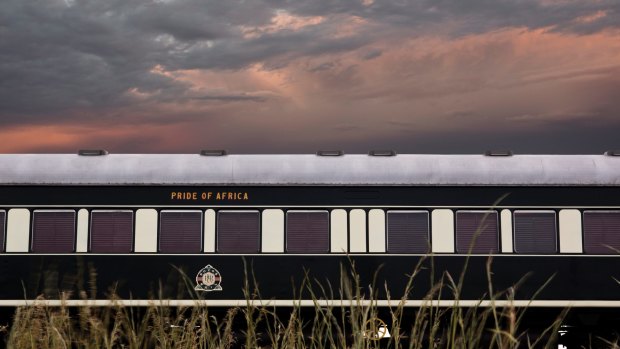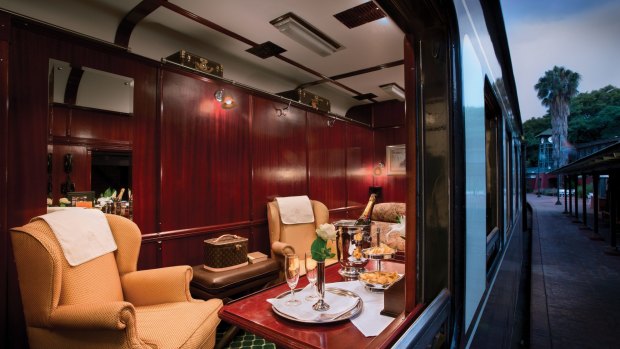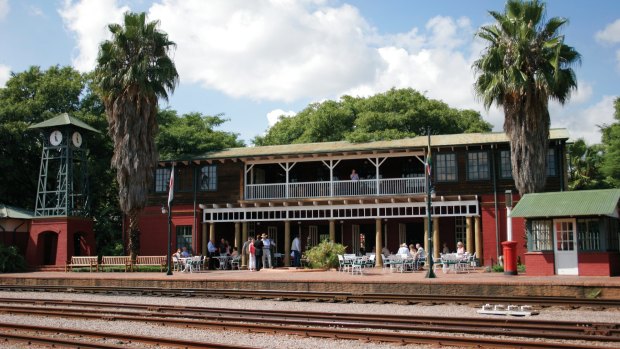This was published 4 years ago
Rovos Rail luxury train from Pretoria to Cape Town, South Africa: A journey straight out of Agatha Christie
By Roy Masters

Rohan Vos boasts that he owns "the largest privately owned train set in the world", which he has named Pride of Africa.
All this journey needs is a dead body and Agatha Christie's typewriter. Rovos Rail, with its luxury train from Pretoria to Cape Town and a cast of intriguing, international passengers, has all the remaining material for a 1930s whodunit in the style of the great British mystery writer.
The waiting room at the privately owned, colonial-style railway station in Capital Park, Pretoria, with its elegant balcony overlooking the platform, sets the tone for the three-day, two-night, 1600-kilometre trip.
Passengers relax in comfortable lounge chairs, sipping champagne and eating cucumber sandwiches from tiered cake stands, while surreptitiously studying their fellow travellers. Smiling men sporting white gloves and green jackets with matching caps tag our luggage. Then, to my surprise, the owner of the railway line, Rohan Vos, makes an appearance. Vos is justifiably proud of his rail line and named it after himself. Tall and thin, looking cool in a long-sleeved shirt and tie despite the 35-degree heat, he invites us to tour his loco sheds. Retired rolling stock, including six 1973 diesel locos from Australia, have been shipped in from overseas and given a luxury makeover.

Inside the luxury train.
It takes three months to transform an unloved old rattler into a five-star Pullman carriage. In eight years, the local workforce has grown to 250 and Vos says most of the workers were previously unemployed and are now skilful tradies.
Vos boasts that he owns "the largest privately owned train set in the world", which he has named "Pride of Africa".
As 3pm departure time approaches and the pre-boarding orientation is completed, Vos stands behind a lectern and calls the passengers onto the train, allowing us to put names to faces. Four young women are Russian; the tall, expensively dressed man and his younger male companion are Norwegian; the retired couple, Americans; an attractive tall woman and her harried husband could be English …

The elegant, privately owned railway station sets the tone for the three-day, two-night, 1600-kilometre trip.
A card outside each cabin displays the names of its two occupants, allowing further identification if required. Inside, the decor is unapologetically luxurious. There are tasteful paintings above the double bed, or twin bed if you request them; an en suite toilet, shower and basin, fluffy white gowns, drawers and hanging space and remote-operated airconditioning. And there is room to stow two soft bags.
Because we have paid Rovos Rail almost 12 months earlier, we have forgotten how much. The bottle of champagne in the closet helps accelerate this memory loss, along with the digital deprivation of no Wi-Fi.
The glass-sided, open-decked observation car, where a waiter named "Lucky" offers three types of gin (pink, blue and clear), provides further opportunity to study fellow passengers as the train passes through Johannesburg and the goldfields of the Witwatersrand.
The name tags of the four glamorous Russian women identify them all as Mrs, which adds to the intrigue. Agatha would have loved their "minder" – a thin and mysterious Russian.
The retired American whom I mentally dub "Weary" because he looks so like Australia's famous wartime doctor, Edward Dunlop, is a railway enthusiast. He stands for hours, studying the rail line and the overhead wires as the train makes its frequent stops, switching from diesel to electric and changing drivers.
His wife, "Mrs Weary", has the thousand-yard stare of a train spotter's widow.
When Vos announced earlier in clipped English that one is required to dress for dinner, I assumed he was joking. It being October and with game parks ahead, jacket and tie haven't made it into my luggage, although I was amazed how many summer outfits my female travelling companions have packed into their small bags.
But when the Norwegians (their Royal suite has a Victorian claw-foot bath tub) appear in smoking jackets and the Russians in cocktail dress, it is time to check with the train manager.
She agrees a tie will be sufficient to admit me to the dining car and Rovos happens to have them on sale in three colours for $US25 ($35).
The dining car, with its mahogany panelling and intimate lighting, has tables of two or four, with printed menus and fine china with the Rovos crest.
A sample dinner includes South African dishes, such as bobotie (spiced mince), drunken pecorino (salad) and melktert (pastry). Ostrich, which tastes like duck-flavoured venison, is also on the menu.
Waiters hover with varieties of South African wine. All alcohol, except French champagne, is part of the package. In fact, the only time it is necessary to produce cash is for tips at the end of the journey and a couple of intervening stops.
Vos had told us our train of 20 carriages has only 36 occupants but has catered for the standard number of 72, meaning we should not be backward in ordering.
Jet lag means bedtime beckons early but so does morning. Lying in bed, with the blind up, lulled by the clickety-clack of the train, while watching the countryside roll by is transporting in more ways than one.
It's daylight an hour before breakfast, so one person can comfortably dress in the small confines while the other stays in bed. The view out the window is not spectacular as we cross the highveld … semi-arid, soft-coloured bushes, abandoned homes and distant mountains. It's where the Boers and British and Australian troops fought at the turn of the 19th century. But most of the sensory pleasure is within the five-star train, not outside.
When we take a mandated stop for the three- and four-star Blue Train, the Trans Karoo or the Orange Express, to rush by, it's hard to suppress a dismissive wave.
The first stop for us to alight is 75 kilometres outside Kimberley, the diamond dity besieged by the Boers. Minibuses wait to take us on the 45-minute drive. Our guide, Frank, introduces himself with a good/bad news joke. The bad news is that the regular driver has been taken to hospital overnight and Frank is replacing him. And he predicts we may not enjoy his driving.
The good news? A former professor of history, he is the most knowledgeable guide in southern Africa.
As it turns out, Frank is indeed a terrifying driver but he redeems himself as a guide, both on a viewing platform adjacent to the Big Hole, the largest man-made excavation in the world, and in the Diamond Museum.
Leaving Kimberley, the Pride of Africa continues its journey to De Aar, a major railway junction to Namibia and the Northern Cape. The vegetation becomes increasingly arid as the train speeds across the Karoo, an inland sea in ancient geological time.
Dinner on the second night is followed by cocktails in the leather armchairs of the lounge car. The bar is sprinkled with rose petals and lined with exotic drinks. The music is loud and the train attendants tell us at breakfast that the "four czarinas" had gone to bed at 2.30am.
Although we enjoy ample exercise walking from the sleeping cars back to the observation deck, or forward to the dining car, it doesn't satisfy those who like to strike out on terra firma. Rovos Rail is cognisant of that and the morning after cocktail night, the train stops five kilometres outside the small town of Matjiesfontein, allowing passengers to walk the track beside the railway line.
The main street of the almost abandoned town, built exclusively in ornate Victorian style, runs parallel to the railway station. The Lord Milner hotel, with its wrought-iron frills, flies the Union Jack, and the old courthouse, dated 1897, is embellished with the letters VR.
The host of the Lord Milner, a short, squat man wearing a vest and top hat, claims to be the descendant of a union between a British general and a lady named "Hot Chocolate". He sits at a piano, takes off his top hat and belts out a medley of songs from Bad Moon Rising to Annie Laurie, inviting all to sing along.
Matjiesfontein was the headquarters of 12,000 British troops during the 1899-1902 Boer War and the local museum holds many relics.
Rovos Rail then climbs down, via four tunnels, to the wine-growing region. Small children run from shanty towns to wave, although the reaction from one platform of adult commuters, as the luxury train speeds by, is understandably sullen. One disappointment, common to all settlements along the route, is rubbish lining the track. It sits at odds with innovations, such as a vast farm of solar panels.
The Pride of Africa reaches Cape Town half an hour late at 6.30pm. Ancient tumbrils roll out to transport our luggage across the street where the entire staff of the train line up to farewell us. The journey ends without an Agatha victim, although "Weary" could have become one had he insisted his wife accompany him on the 15-day trip to Dar Es Salaam.
TRIP NOTES
MORE
FLY
Qantas flies to Johannesburg's International Airport via Sydney and South African Airways via Perth. Take land transport (45-minute trip) to Pretoria.
STAY
If you need to stay overnight in Pretoria ahead of the Rovos Rail departure for Cape Town at 3pm, stay in comfortable guest houses.
TOUR
Local travel companies, such as Ulysses Tours and Travel (reservations@ulysses.co.za) offer half-day city tours of Pretoria and a visit to the Voortrekker Monument.
PRICE
Rovos Rail's three-day, two-night Pretoria to Cape Town Pullman suite costs $2390; the Deluxe suite $3650 and the Royal suite $4890. Trains run regularly through the year, including the reverse direction from Cape Town to Pretoria.
The price covers all meals, all alcoholic and other beverages except French champagne; 24-hour full room service and bar; limited laundry service; guided excursion and entrance fees; government tax. See reservations@rovos.co.za
Roy Masters travelled at his own expense.
Sign up for the Traveller Deals newsletter
Get exclusive travel deals delivered straight to your inbox. Sign up now.